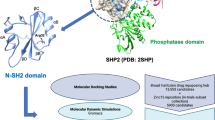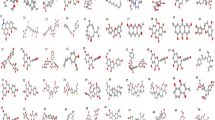Abstract
Ganoderma, in the recent years, has been comprehensively characterized and held invaluable for their miscellaneous pharmacological activities. Recently, attempts to explore and fathom the pathway of inhibition revealed GA-A and GA-H to impede the progression of breast cancer by inhibiting the signaling of AP-1 and NF-κB, although the mechanism has not yet been explored. NF-κB is a key transcription factor having irrefutable role in cell proliferation, apoptosis and cancer signaling and its subunits κB-IKKα, IKKβ and IKKγ (NEMO) are pivotal to the cancer signaling mechanism. The present study confirmed mechanistically the association between NF-κB and NEMO in regulating the signaling cascade of NF-κB. GA-A and GA-H were observed to participate in various non-covalent interactions, thus contributing largely to the stability of the ligand–macromolecules association as well as their role as anticancer agent in breast cancer. Amino acids, Lys90 and Asn732, were seen to be critically involved in the signaling cascade. Apart from this, residues Glu98 and Met94, Cys95 and Glu91 were involved in hydrogen bonding in GA-A and GA-H. The anticancer activity exhibited by GA-A and GA-H is attributed to certain docking poses and interaction that were found to be absent in the GA-F such as hydroxylation at 3 and 7 and/or 15 in the lanostane structure. This study is the first of its kind elucidating a possible mode of binding of ganoderic acid in NF-κB signaling pathway using molecular modeling studies, further evaluated by differential calculation-based algorithms.







Similar content being viewed by others
References
Agou F, Ye F, Goffinont S, Courtois G, Yamaoka S, Israël A, Véron M (2002) NEMO trimerizes through its coiled-coil C-terminal domain. J Biol Chem 277:17464–17475
Allgayer H (2010) Pdcd4, a colon cancer prognostic that is regulated by a microRNA. Crit Rev Oncol/Hematol 73:185–191
Biswas DK, Shi Q, Baily S, Strickland I, Ghosh S, Pardee AB, Iglehart JD (2004) NF-κB activation in human breast cancer specimens and its role in cell proliferation and apoptosis. Proc Natl Acad Sci USA 101:10137–10142
Chen N-H, Liu J-W, Zhong J-J (2010) Ganoderic acid T inhibits tumor invasion in vitro and in vivo through inhibition of MMP expression. Pharmacol Rep 62:150
Daschner PJ, Ciolino HP, Plouzek CA, Yeh GC (1999) Increased AP-1 activity in drug resistant human breast cancer MCF-7 cells. Breast Cancer Res Treat 53:229–240
Dolcet X, Llobet D, Pallares J, Matias-Guiu X (2005) NF-kB in development and progression of human cancer. Virchows Arch 446:475–482
Fasshauer D, Sutton RB, Brunger AT, Jahn R (1998) Conserved structural features of the synaptic fusion complex: SNARE proteins reclassified as Q-and R-SNAREs. Proc Natl Acad Sci 95:15781–15786
Ghosh S, Karin M (2002) Missing pieces in the NF-κB puzzle. Cell 109:S81–S96
Giuliani C, Napolitano G, Bucci I, Montani V, Monaco F (2001) Nf-kB transcription factor: role in the pathogenesis of inflammatory, autoimmune, and neoplastic diseases and therapy implications]. La Clin Terapeutica 152:249
Grover A, Shandilya A, Punetha A, Bisaria VS, Sundar D (2010) Inhibition of the NEMO/IKKβ association complex formation, a novel mechanism associated with the NF-κB activation suppression by Withania somnifera’s key metabolite withaferin A. BMC Genom 11:S25
Jiang J, Grieb B, Thyagarajan A, Sliva D (2008) Ganoderic acids suppress growth and invasive behavior of breast cancer cells by modulating AP-1 and NF-κB signaling. Int J Mol Med 21:577–584
Marienfeld RB, Palkowitsch L, Ghosh S (2006) Dimerization of the IκB kinase-binding domain of NEMO is required for tumor necrosis factor alpha-induced NF-κB activity. Mol Cell Biol 26:9209–9219
May MJ, Marienfeld RB, Ghosh S (2002) Characterization of the IκB-kinase NEMO binding domain. J Biol Chem 277:45992–46000
Rushe M, Silvian L, Bixler S, Chen LL, Cheung A, Bowes S, Cuervo H, Berkowitz S, Zheng T, Guckian K (2008) Structure of a NEMO/IKK-associating domain reveals architecture of the interaction site. Structure 16:798–808
Schomer-Miller B, Higashimoto T, Lee Y-K, Zandi E (2006) Regulation of IκB kinase (IKK) complex by IKKγ-dependent phosphorylation of the T-loop and C terminus of IKKβ. J Biol Chem 281:15268–15276
Sliva D (2004) Signaling pathways responsible for cancer cell invasion as targets for cancer therapy. Curr Cancer Drug Targets 4:327–336
Suarez-Arroyo IJ, Rosario-Acevedo R, Aguilar-Perez A, Clemente PL, Cubano LA, Serrano J, Schneider RJ, Martínez-Montemayor MM (2013) Anti-tumor effects of ganoderma lucidum (Reishi) in inflammatory breast cancer in vivo and in vitro models. PLoS ONE 8:e57431
Tak PP, Firestein GS (2001) NF-κB: a key role in inflammatory diseases. J Clin Invest 107:7–11
Acknowledgments
Authors thank Central University of Punjab, Bathinda, for providing the necessary facilities to carry out the present work.
Author information
Authors and Affiliations
Corresponding author
Rights and permissions
About this article
Cite this article
Gill, B.S., Kumar, S. Differential algorithms-assisted molecular modeling-based identification of mechanistic binding of ganoderic acids. Med Chem Res 24, 3483–3493 (2015). https://doi.org/10.1007/s00044-015-1405-x
Received:
Accepted:
Published:
Issue Date:
DOI: https://doi.org/10.1007/s00044-015-1405-x




